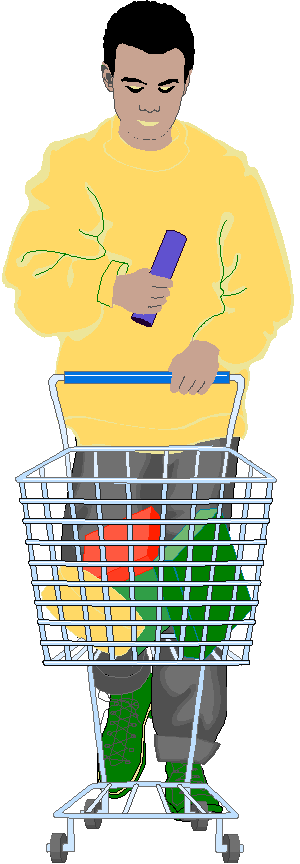- The read distance for an RFID device can be greater than for a UPC symbol.
- RFID doesn't require line-of-sight readers.
- For readability, RFID technology doesn't require alignment or fancy scanners.
- Reduced human involvement. That means fewer errors, lower inventory shrinkage, faster turnaround and lower costs.
- Counterfeit resistance.
Targeted Marketing
Friendly surveillance. Increasingly, operations use RFID tags in data collection for "friendly surveillance," such as targeted marketing. Now this isn't your grandfather's "surveillance." Instead, RFID saves money and time. Those savings apply to both the marketer and the customer.
Saves time & money. For example, imagine that you're a customer at an RFID-enabled grocery store. A smart cash register functions as a terminal for this store's data warehouse. The cash register captures data from your RFID "courtesy card" and from products in your cart. The data warehouse relates purchase information and purchase date to account number. After this data processing, the store knows what and when you buy. When you buy more of the same item, the store knows how long the product lasts. So far, RFID follows the pattern that stores already use with credit card marketing.
Automatic store coupons. Now the store can provide a coupon for the exact item that you want. The store can also stock more of the preferred sizes and brands. Store coupons arrive exactly when you need to repurchase. A coupon might even pop up on your home computer. Or, the store can upload a coupon to your courtesy card. At checkout time, this credit reduces your bill. If the coupon is paper, a shopping aisle reader can print the coupon. You never need to clip the coupon out of the newspaper. Instead, an RFID reader spots your courtesy card. The system relays coupon information to the nearest printer. As you pass by, out comes the coupon!
Automatic checkout. Best of all, RFID technology can sense product and pricing data for everything in your shopping cart. Checkout is easy. You never need to unload your cart!
How RFID works
Data storage & retrieval. RFID technology stores and retrieves data on RFID tags. An RFID tag houses two parts: An RFID circuit and antenna. The RFID circuit stores the data. Another name for this circuit is the transponder. When the tag comes close to a RFID reader, the reader captures the card data. The reader sends the captured data to a processor. Following its program, the processor responds by performing some action.
Nature of ID. The tag's read-only memory contains the digitally encoded identifier. This ID is the electronic product code (EPC). For example, a stock number, account number or employee number. This ID is unique and unchangeable.
Inside RFID
Three Parts. RFID technology has three parts...
| • RFID tag | • RFID reader | • Back-end, data warehouse & processor |
RFID Tag
Transponder. An RFID tag houses the RFID transponder circuit. The circuit is a radio transceiver with memory. The RFID tag contains an antenna and a silicon chip. The chip circuit can modulate or demodulate an RF carrier. A small amount of onboard memory can store permanent and sometimes temporary data. To intelligently operate the other electronics, RFID circuits also include an embedded microcontroller. Other names for RFID cards are "contactless," "proximity," "proxy" or "smart" cards.
Go to Page: 1 2 3 4 Next
